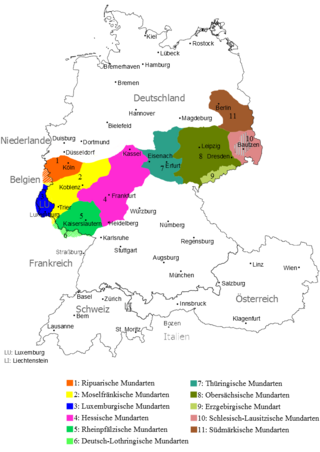
Back Alto saxón AN Altu saxón AST Hornosaské dialekty Czech Obersächsische Dialekte German Suprasaksa germana dialekto Esperanto Alto sajón Spanish סקסונית עילית HE Gornjosaski jezik Croatian Lingua alto-sassone Italian Hoegsaksisch LI
This article needs additional citations for verification. (August 2007) |
| Upper Saxon | |
|---|---|
| Obersächsisch | |
| Native to | Germany |
| Region | Saxony |
Native speakers | (2 million cited 1998)[1] |
| Language codes | |
| ISO 639-3 | sxu |
| Glottolog | uppe1465 |
 Central German dialects after 1945 and the expulsions of the Germans
Upper Saxon (8) | |
Upper Saxon (German: Obersächsisch, pronounced [ˈoːbɐˌzɛksɪʃ]; Upper Saxon: [ɵːb̥oˤˈsɛɡ̊sʃ]) is an East Central German dialect spoken in much of the modern German state of Saxony and in adjacent parts of southeastern Saxony-Anhalt and eastern Thuringia. As of the early 21st century, it is mostly extinct and a new regiolect (also known as obersächsische Umgangssprache) has emerged instead.[2] Though colloquially called "Saxon" (Sächsisch), it is not to be confused with the Low Saxon dialect group in Northern Germany. Upper Saxon is closely linked to the Thuringian dialect spoken in the adjacent areas to the west.
Standard German has been heavily based on Upper Saxon, especially in its lexicon and grammar. This is due to it being used as the basis for early developments in the standardization of German during the early 1500s, including the translation of the Bible by Martin Luther.[3]
- ^ Upper Saxon at Ethnologue (18th ed., 2015) (subscription required)
- ^ Siebenhaar, Beat. "Der obersächsische Sprachraum". Leipzig University. Retrieved 2 June 2019.
- ^ Sächsische Hochsprache, Deutsche Welle. Retrieved 10 January 2021. (in German)
© MMXXIII Rich X Search. We shall prevail. All rights reserved. Rich X Search